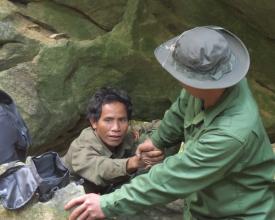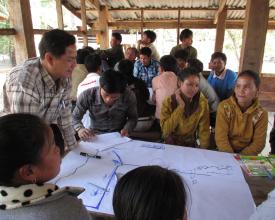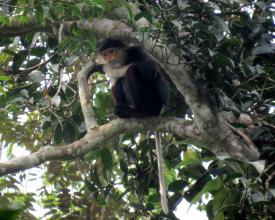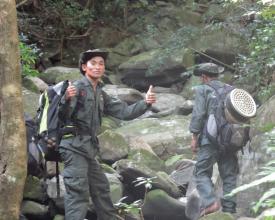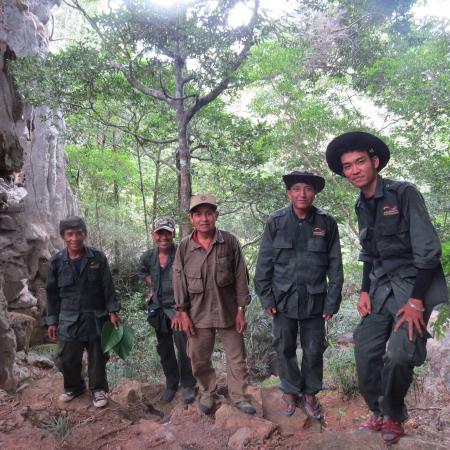
Une main-d'œuvre locale supplémentaire améliore l'efficacité de la gestion des zones protégées
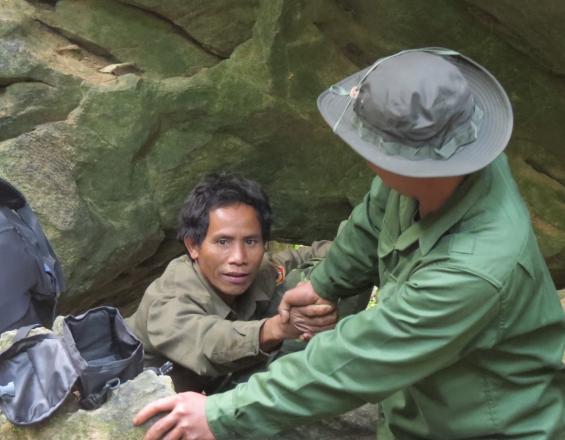
Une unité de gestion et des structures de cogestion ont été mises en place avec la participation de 244 personnes issues de différents groupes d'acteurs (gestion de la zone nationale protégée de Hin Nam No en République démocratique populaire lao). Auparavant, seules 9 à 12 personnes travaillaient à la gestion de ce site de 82 000 hectares. Grâce à l'apport de main-d'œuvre et de connaissances supplémentaires de la part des villageois locaux, le score total d'efficacité de la gestion de la zone nationale protégée de Hin Nam No a augmenté de 13 % en deux ans. L'organisation locale AFC a étendu cette solution à d'autres régions du Laos.
Contexte
Défis à relever
Le manque d'application de la loi, de connaissances, de compétences et un budget insuffisant font que la gestion des aires protégées au Laos ressemble à une approche de parc sur papier en raison de l'insuffisance du budget et de l'allocation des ressources humaines par le gouvernement. De plus, Hin Nam No n'a pas d'unité de gestion spécifique dotée d'un personnel à temps plein et les responsabilités sont réparties entre différents départements. Il y a un manque d'information, d'application de la loi, de capacité, de connaissances et de compétences pour gérer efficacement l'aire protégée et en assurer le suivi.
Emplacement
Traiter
Résumé du processus
La mise en place de la structure de gestion et la rédaction des termes de référence pour les différentes unités par l'autorité de l'AP ont contribué à la description des tâches à accomplir pour gérer efficacement l'AP de Hin Nam No. L'autorité de l'AP ne pouvant affecter que 2 à 3 fonctionnaires de district par unité, il est apparu clairement que certaines tâches devaient être déléguées à la population locale. Cela a également été confirmé par l'évaluation de base de la gouvernance. La nécessité d'une cogestion est donc venue des autorités de l'AP et la population locale était impatiente d'accepter, puisqu'elle a participé à la rédaction d'accords de cogestion décrivant des incitations claires pour leur participation, sur la base de droits coutumiers sur certaines zones. Le renforcement des capacités des autorités de l'AP et des villageois leur a permis de mieux s'acquitter de leurs tâches. L'approbation officielle de la structure de gestion coordonnée verticalement et des accords de cogestion par le gouverneur du district a légitimé l'approche. L'augmentation de 13 % de l'efficacité de la gestion après deux ans a convaincu les parties prenantes de poursuivre ce partenariat. L'AFC a mis en œuvre des parties du modèle dans d'autres régions du Laos et a reproduit certains éléments de base en utilisant du matériel de formation expliquant les éléments de base en détail.
Blocs de construction
Zonage participatif utilisant les droits et les connaissances coutumiers
Facteurs favorables
Leçon apprise
La population locale comme main-d'œuvre supplémentaire pour la gestion des aires protégées
Facteurs favorables
Leçon apprise
Évaluation de la gouvernance par le biais d'une consultation participative
Facteurs favorables
Leçon apprise
Mise en place d'une structure de gestion coordonnée verticalement
Facteurs favorables
Leçon apprise
Accords de cogestion
Facteurs favorables
Leçon apprise
Mise à l'échelle du modèle
Facteurs favorables
Leçon apprise
Ressources
Impacts
Conservation des espèces : Des gardes villageois sont mis en place, formés et capables de travailler seuls pour effectuer des patrouilles et surveiller la biodiversité. Nombre d'animaux sauvages observés : 2561 (1844 animaux indicateurs). Une population constante d'animaux sauvages et un déclin des activités illégales (braconnage, exploitation forestière illégale) ont pu être observés. Bénéfices pour les prestataires de services du village : 793 000 LAK (base de référence) plus 8,8 % (37 % pour les femmes) de revenus mensuels supplémentaires provenant des services d'écotourisme pour tous les ménages concernés (35 ménages dans 4 villages). Il y a une augmentation de 465 visiteurs de la saison sèche (2013/14) à 2520 visiteurs dans la saison sèche (2015/16). En 2015, un total de 110 gardes villageois formés ont parcouru 1523 km de patrouille couvrant 60% du parc. Pour cela, un total rentable de 12 000 US$ a été payé aux gardes villageois. Amélioration de la gestion : Augmentation de 15 % du score de bonne gouvernance et de 13 % du score d'efficacité de la gestion en 2016 par rapport à 2014. Des accords de cogestion ont été rédigés de manière participative pour 19 villages et 5 groupes de villages et ont été approuvés et signés lors d'un suivi au niveau du district. Ainsi, les tâches de gestion du parc sont officiellement déléguées aux villageois de 19 villages. L'AFC a soutenu trois organisations de la société civile pour mettre en œuvre le modèle ailleurs au Laos (21 accords de cogestion villageois supplémentaires officiellement approuvés, couvrant 204 747 ha de forêts villageoises).
Bénéficiaires
Autorité de gestion de la zone protégée et villageois environnants ayant des droits coutumiers
Histoire

Depuis que les gardes villageois surveillent régulièrement la faune et les menaces à l'intérieur du parc de Hin Nam No, les arrestations de braconniers sont de plus en plus fréquentes. Le lundi 28 juillet 2014, une équipe de 8 gardes forestiers du village de Ban Dou a effectué sa patrouille forestière régulière, lorsqu'elle est tombée sur une équipe de cinq braconniers vietnamiens dans la région de Kuan Nong. Cet endroit se trouve à une journée de marche du village et à trois jours de marche de la frontière vietnamienne. Ces braconniers disposaient d'un grand nombre de câbles de freins de moto, un matériau très utilisé pour fabriquer des pièges, ainsi que d'explosifs et de matériel de creusement. Ils cherchaient à creuser pour trouver les racines d'un arbre précieux, le bois de rose, et espéraient piéger des singes et d'autres animaux sauvages pour les manger. Les gardes forestiers du village ont arrêté les braconniers, les ont ligotés avec leurs propres câbles et les ont ramenés au village. Les braconniers ont été remis au poste militaire frontalier de Ban Dou, qui les a gardés pendant trois jours. Les autorités compétentes ont été appelées et une réunion a été organisée pour juger l'affaire. Le comité de jugement a décidé d'une amende équivalente à 3 000 USD, considérant que les braconniers avaient été pris sur le fait, mais qu'ils n'avaient pas collecté de bois illégal ou d'animaux sauvages susceptibles d'être confisqués. Les braconniers ont été avertis qu'ils avaient eu de la chance que l'affaire soit résolue au niveau du groupe de villages. Si l'affaire avait été transférée au niveau de la province, la procédure aurait été beaucoup plus longue et l'amende au moins trois fois plus élevée. Les parents des braconniers du côté vietnamien de la frontière ont été informés que les braconniers avaient été arrêtés et qu'ils ne seraient libérés qu'une fois l'amende payée. Les parents sont arrivés dans la journée et ont payé la totalité de l'amende en espèces. Les braconniers ont ensuite été libérés et sont retournés le même jour dans leur ville natale de Phong Nha, dans la province voisine de Quang Binh. L'ensemble de la procédure a duré 4 jours. L'amende de 3 000 dollars a été répartie entre les différents acteurs de l'application de la loi. Les gardes forestiers qui ont trouvé et arrêté les braconniers ont reçu une récompense de 124 dollars par braconnier arrêté, soit un total de 620 dollars. Une somme supplémentaire de 200 dollars a été dépensée pour nourrir les gardes forestiers et leurs prisonniers. La somme restante de 2180 dollars a été divisée à parts égales entre les responsables du groupe de villages locaux de Ban Dou et l'autorité du parc du district.

